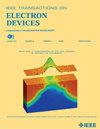Multifrequency-Coded RFID Microstrip Photosensor Based on ZnOAgCuS Nanocomposites
IF 2.9
2区 工程技术
Q2 ENGINEERING, ELECTRICAL & ELECTRONIC
引用次数: 0
Abstract
Radio frequency identification (RFID) is widely used in indoor lighting systems due to advantages, such as programmability, stability, and high detection accuracy. Herein, a multifrequency-coded RFID microstrip photosensor based on zinc oxide (ZnO)/silver (Ag)/copper sulfide (CuS) nanocomposites is designed; at the same time, it has the excellent photoelectric performance of ZnO and CuS, which enhances the response of the sensor to the light signal, and the high photoconductivity of Ag, enhances the RFID radio frequency signal, improves the reading distance and accuracy, and can be used to detect the light of four frequencies. A complementary open-loop resonator (CSRR) patch microstrip antenna was designed using high-frequency structure simulator (HFSS) software, and the structure of the photosensor was optimized. Three coding rings are designed by adjusting the length and width of the patch, so that the sensor can realize three-digit coding, and the actual antenna is prepared by sculpting technology. The nanorod-like ZnO, nanolinear Ag, and spherical CuS are prepared by a hydrothermal method, and their structures and morphologies are characterized by SEM, energy-dispersive X-ray spectrometry (EDS), XRD, TEM, and XPS. The amplitude of the antenna under the code “111” is −26.49 dB, and the detection performance is the best. The sensor made by drip coating can detect ambient light in the range of 2.833–2.928 GHz. For a light intensity of 0–53.9 klx, the response time of the photosensor is 17 s, the recovery time is 15 s, the response time of the resistance is 16 s, and the recovery time is 11 s, indicating that the ZnO/Ag/CuS nanocomposites have good responsiveness and recovery.基于 ZnOAgCuS 纳米复合材料的多频编码 RFID 微带光传感器
射频识别(RFID)具有可编程性、稳定性和高检测精度等优点,被广泛应用于室内照明系统。本文设计了一种基于氧化锌(ZnO)/银(Ag)/硫化铜(CuS)纳米复合材料的多频编码 RFID 微带光传感器,同时具有 ZnO 和 CuS 的优异光电性能,可增强传感器对光信号的响应,以及 Ag 的高光导率,可增强 RFID 射频信号,提高读取距离和精度,并可用于检测四种频率的光。利用高频结构模拟器(HFSS)软件设计了互补开环谐振器(CSRR)贴片微带天线,并优化了光传感器的结构。通过调整贴片的长度和宽度,设计了三个编码环,使传感器可以实现三位编码,并通过雕刻技术制备了实际天线。采用水热法制备了纳米棒状 ZnO、纳米线状 Ag 和球状 CuS,并通过扫描电子显微镜、能量色散 X 射线光谱仪(EDS)、XRD、TEM 和 XPS 对它们的结构和形态进行了表征。代码 "111 "下的天线振幅为-26.49 dB,探测性能最佳。用滴水涂层制作的传感器可以检测到 2.833-2.928 GHz 范围内的环境光。在光强为 0-53.9 klx 时,光传感器的响应时间为 17 秒,恢复时间为 15 秒,电阻的响应时间为 16 秒,恢复时间为 11 秒,表明 ZnO/Ag/CuS 纳米复合材料具有良好的响应性和恢复性。
本文章由计算机程序翻译,如有差异,请以英文原文为准。
求助全文
约1分钟内获得全文
求助全文
来源期刊

IEEE Transactions on Electron Devices
工程技术-工程:电子与电气
CiteScore
5.80
自引率
16.10%
发文量
937
审稿时长
3.8 months
期刊介绍:
IEEE Transactions on Electron Devices publishes original and significant contributions relating to the theory, modeling, design, performance and reliability of electron and ion integrated circuit devices and interconnects, involving insulators, metals, organic materials, micro-plasmas, semiconductors, quantum-effect structures, vacuum devices, and emerging materials with applications in bioelectronics, biomedical electronics, computation, communications, displays, microelectromechanics, imaging, micro-actuators, nanoelectronics, optoelectronics, photovoltaics, power ICs and micro-sensors. Tutorial and review papers on these subjects are also published and occasional special issues appear to present a collection of papers which treat particular areas in more depth and breadth.
 求助内容:
求助内容: 应助结果提醒方式:
应助结果提醒方式:


